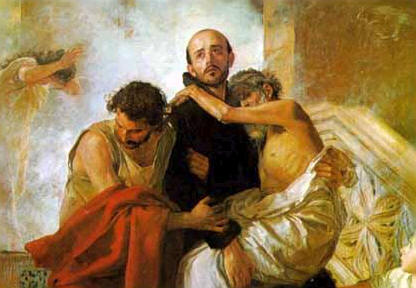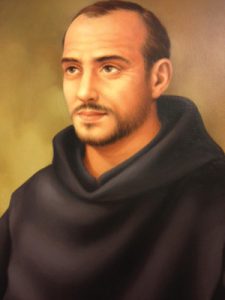
St. John of God was a shepherd and a soldier, who had a dramatic conversion and became the founder of a charitable religious order. John was born at Montemayor-el-Novo, Portugal in 1495, the only child of middle-class parents. At age eight, John inexplicably vanished, and it is not known whether he was kidnapped or was lured away. He eventually ended up as a homeless street child in Oropesa, in the kingdom of Castile, Spain, nearly nine hundred miles away. He survived on whatever food and shelter he could find, and eventually made his way to the nearby hills where he worked as a shepherd-boy until he was twenty two.
SHEPHERD BOY TO SOLDIER
It was the early 1500’s, and Spain was spreading its influence far beyond its borders. Tales of adventures, wealth, and great battles held much appeal to young men, and John was no exception. He served as a soldier against the French in northern Basque Spain, against the Turks in Hungary, and several other places, until the age of forty. While he had retained his religious faith while living as a shepherd, the years John spent living the rough life of a soldier made him hard hearted, and he abandoned the morality and beliefs of his childhood. On one occasion, he fell from his horse during a looting raid and nearly died. This brush with death caused him to recall the prayers of his childhood, and he turned to the intercession of the Virgin Mary to save his life. The experience caused a change in him, and he determined to leave the army as soon as he could. After their last campaign, John’s regiment was left in northwestern Spain. From there, John made a pilgrimage to Santiago de Compostela, where he made his Confession and dedicated the rest of his life to God.
“GRANADA SHALL BE YOUR CROSS”
Resolved to find his family, he went to his hometown and learned that his mother had died “of a broken heart” and his father had also died after having lived many years as a Franciscan friar. Blaming himself for their deaths, he returned to Spain, and found work again as a shepherd near Seville. Now with a lot of free time on his hands, he worked on improving his prayer life. He became aware of his own wretchedness and deeply regretted the time he had wasted. He resolved to make amends and went for a time to north Africa, then to Granada, Spain. On the way, he encountered a young homeless boy in rags who begged to be carried, and John obliged. When they stopped for a drink of water, the child became transfigured and said, “John of God, Granada shall be your cross,” and he vanished.
FINDING HIS TRUE MISSION
At Granada, John opened a shop where he sold religious articles and spent his free time in the neighborhood church. [St.] John of Avila, a magnificent preacher of his time, made a visit to the church in 1537 and deeply moved John, who was still searching for his life’s mission. John felt compelled to do public penance to the point of humiliating himself. He became hysterical, cried, struck himself, and rolled in the dirt. This was not a true mental problem, but rather was his desire for complete humiliation. When it happened another time, some bystanders physically brought him to an asylum, where his behavior continued. John of Avila, knowing that John was not mentally ill, but rather misguided, visited him, convinced him of his foolishness and pridefulness, and obtained his release. After John visited a Marian shrine, he returned to Granada with a mission: giving shelter and care to the homeless. He rented a house and gathered the street-beggars, cripples, convicts and others who needed his help. He was known to carry these unfortunates to the house on his own back if necessary. At first, he did all the work for his dependents himself – feeding, clothing and bathing them. His experience in the military was helpful for tending to wounds. John would beg in the streets for needed provisions, and some people went to see what he was doing with the money. When they saw what was being done, support came in, including from the most influential citizens. Expanding his focus beyond the homeless and destitute, John began to seek out others who needed help, and made brothel workers a particular object for his help in making a new start. Because of his colorful history, some distrusted him and his work and he was summoned by the local bishop. The kindly man bestowed the name John of God upon him as given by the mysterious child, and asked him to wear a habit to indicate ecclesial approval. John began to form a staff of volunteers, several of whom were those he had helped. The work was not easy, for the patients often bickered and there was still suspicion and opposition. However, he persevered in this work for the rest of his life. He had been sick for some time, but kept it to himself. When he dove into a river to save a drowning man, however, he became much worse and was tended to in his own hospital. He was given last rites by the bishop and died March 5, 1550, on his knees with his head resting on a crucifix. He was fifty-five.

CROOKED PATHWAY TO SAINTHOOD
St. John of God had a crooked pathway before he found his life’s mission. His time as a child of the streets undoubtedly gave him a special compassion for the destitute of body and soul, who he personally tucked into bed each night. With almost no education or special training, but a humble charitable heart, he unknowingly began a religious order, for twenty years after he died, the Brothers Hospitallers was formed from his mission. It is now serving the sick poor in forty-six countries. John of God was canonized in 1690 and is the patron of hospitals, nurses, and the sick. His feast day is observed March 8.
